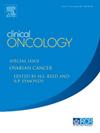Evaluation of Gross Tumour Volume in Head and Neck Cancers on Contrast-Enhanced Computed Tomography vs Magnetic Resonance Imaging and its Implications on Dice Similarity Coefficients and Dose-Volume Parameters
IF 3
3区 医学
Q2 ONCOLOGY
引用次数: 0
Abstract
Aims
Radiotherapy treatment planning for head and neck cancers (HNCs) is usually based on contrast-enhanced computed tomography (CECT). However, soft-tissue contrast is better evident in magnetic resonance imaging (MRI). The study evaluates the gross tumour volumes (GTVs) delineated on CECT vs MRI along with their Dice similarity coefficients (DSCs) and resultant impact on the dose-volume histogram (DVH) parameters, conformity index (CI), and homogeneity index (HI) during intensity-modulated radiotherapy (IMRT) planning in HNCs.
Material and Methods
This prospective study enrolled 50 consecutive HNC patients. Following CECT and MRI simulations, GTVp (primary) and GTVn (node) were delineated independently on these co-registered images. Corresponding MRI volumes were then copied onto co-registered CECT images and IMRT plans were generated on the CECT-defined planning target volume (PTV) of primary and nodes (PTVp+n).
Results
The GTVp, GTVn, and GTVp+n observed on MRI were significantly larger than the corresponding GTVs defined on CECT (all P < .001). The DSC of GTVp, GTVn, and GTVp+n was inversely correlated with the corresponding % differences of GTVp (r = -0.49, P < .001), GTVn (r = -0.41, P = .021), and GTVp+n (r = -0.73, P < .001) between CECT and MRI. The mean DSCs of GTVp, GTVn, GTVp+n, and PTVp+n were 0.78, 0.32, 0.67, and 0.78, respectively. This led to significant differences in CI and HI (both P < .001), as well as other DVH parameters (D2, D50, D95, D98, V95, and V100, all P < .001) between CECT- and MRI-defined PTVp+n.
Conclusion
The GTVs and PTVp+n defined on MRI were significantly greater than those depicted on CECT, resulting in significant differences in DSC, DVH parameters, CI, and HI. Thus, IMRT planning for HNCs based on CECT-defined PTV appears inappropriate. The study emphasises the importance of accurate delineation to ensure adequate coverage of the target volume and the potential benefit of MRI in this regard.
对比增强计算机断层扫描与磁共振成像对头颈部肿瘤体积的评价及其对骰子相似系数和剂量-体积参数的影响
目的头颈癌(HNCs)的放射治疗计划通常基于对比增强计算机断层扫描(CECT)。然而,软组织对比在磁共振成像(MRI)中更为明显。该研究评估了CECT与MRI所描绘的总肿瘤体积(gtv)及其Dice相似系数(dsc),以及在调强放疗(IMRT)计划期间对HNCs剂量-体积直方图(DVH)参数、符合性指数(CI)和均匀性指数(HI)的影响。材料和方法本前瞻性研究纳入了50例连续的HNC患者。通过CECT和MRI模拟,在这些共配准图像上独立描绘GTVp(原发性)和GTVn(节点)。然后将相应的MRI体积复制到共配准的CECT图像上,并在CECT定义的主要和节点的规划目标体积(PTV) (PTVp+n)上生成IMRT计划。结果MRI上观察到的GTVp、GTVn和GTVp+n均明显大于CECT上定义的相应gtv (P <;措施)。GTVp、GTVn和GTVp+n的DSC与GTVp相应的%差异呈负相关(r = -0.49, P <;措施),GTVn (r = -0.41, P = .021)和GTVp + n (r = -0.73, P & lt;.001)。GTVp、GTVn、GTVp+n和PTVp+n的平均dsc分别为0.78、0.32、0.67和0.78。这导致CI和HI的显著差异(P <;.001),其他DVH参数(D2、D50、D95、D98、V95、V100)均P <;.001)在CECT和mri定义的PTVp+n之间。结论MRI显示的gtv和PTVp+n明显大于CECT,导致DSC、DVH参数、CI、HI差异显著。因此,基于cect定义的PTV对HNCs进行IMRT计划似乎是不合适的。该研究强调了准确描绘的重要性,以确保目标体积的充分覆盖,以及MRI在这方面的潜在益处。
本文章由计算机程序翻译,如有差异,请以英文原文为准。
求助全文
约1分钟内获得全文
求助全文
来源期刊

Clinical oncology
医学-肿瘤学
CiteScore
5.20
自引率
8.80%
发文量
332
审稿时长
40 days
期刊介绍:
Clinical Oncology is an International cancer journal covering all aspects of the clinical management of cancer patients, reflecting a multidisciplinary approach to therapy. Papers, editorials and reviews are published on all types of malignant disease embracing, pathology, diagnosis and treatment, including radiotherapy, chemotherapy, surgery, combined modality treatment and palliative care. Research and review papers covering epidemiology, radiobiology, radiation physics, tumour biology, and immunology are also published, together with letters to the editor, case reports and book reviews.
 求助内容:
求助内容: 应助结果提醒方式:
应助结果提醒方式:


